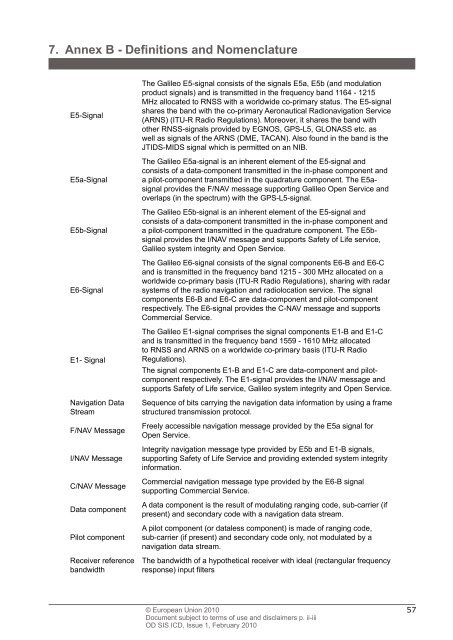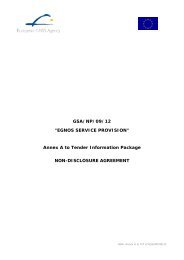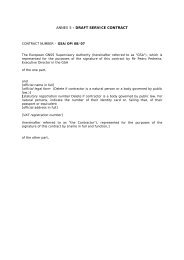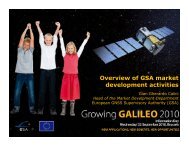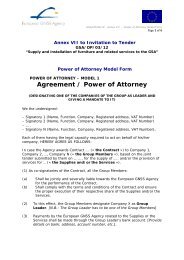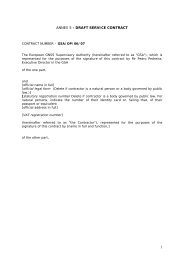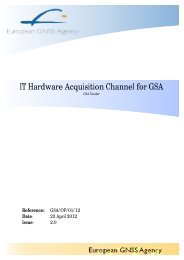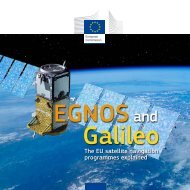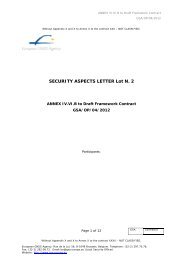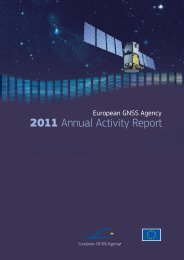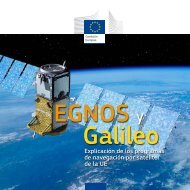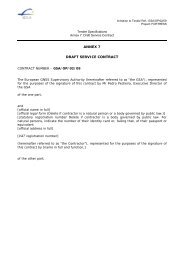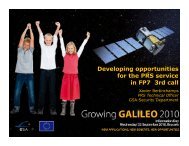Galileo OS SIS ICD.indd - GSA - Europa
Galileo OS SIS ICD.indd - GSA - Europa
Galileo OS SIS ICD.indd - GSA - Europa
You also want an ePaper? Increase the reach of your titles
YUMPU automatically turns print PDFs into web optimized ePapers that Google loves.
7. Annex B - Defi nitions and Nomenclature<br />
E5-Signal<br />
E5a-Signal<br />
E5b-Signal<br />
E6-Signal<br />
E1- Signal<br />
Navigation Data<br />
Stream<br />
F/NAV Message<br />
I/NAV Message<br />
C/NAV Message<br />
Data component<br />
Pilot component<br />
Receiver reference<br />
bandwidth<br />
The <strong>Galileo</strong> E5-signal consists of the signals E5a, E5b (and modulation<br />
product signals) and is transmitted in the frequency band 1164 - 1215<br />
MHz allocated to RNSS with a worldwide co-primary status. The E5-signal<br />
shares the band with the co-primary Aeronautical Radionavigation Service<br />
(ARNS) (ITU-R Radio Regulations). Moreover, it shares the band with<br />
other RNSS-signals provided by EGN<strong>OS</strong>, GPS-L5, GLONASS etc. as<br />
well as signals of the ARNS (DME, TACAN). Also found in the band is the<br />
JTIDS-MIDS signal which is permitted on an NIB.<br />
The <strong>Galileo</strong> E5a-signal is an inherent element of the E5-signal and<br />
consists of a data-component transmitted in the in-phase component and<br />
a pilot-component transmitted in the quadrature component. The E5asignal<br />
provides the F/NAV message supporting <strong>Galileo</strong> Open Service and<br />
overlaps (in the spectrum) with the GPS-L5-signal.<br />
The <strong>Galileo</strong> E5b-signal is an inherent element of the E5-signal and<br />
consists of a data-component transmitted in the in-phase component and<br />
a pilot-component transmitted in the quadrature component. The E5bsignal<br />
provides the I/NAV message and supports Safety of Life service,<br />
<strong>Galileo</strong> system integrity and Open Service.<br />
The <strong>Galileo</strong> E6-signal consists of the signal components E6-B and E6-C<br />
and is transmitted in the frequency band 1215 - 300 MHz allocated on a<br />
worldwide co-primary basis (ITU-R Radio Regulations), sharing with radar<br />
systems of the radio navigation and radiolocation service. The signal<br />
components E6-B and E6-C are data-component and pilot-component<br />
respectively. The E6-signal provides the C-NAV message and supports<br />
Commercial Service.<br />
The <strong>Galileo</strong> E1-signal comprises the signal components E1-B and E1-C<br />
and is transmitted in the frequency band 1559 - 1610 MHz allocated<br />
to RNSS and ARNS on a worldwide co-primary basis (ITU-R Radio<br />
Regulations).<br />
The signal components E1-B and E1-C are data-component and pilotcomponent<br />
respectively. The E1-signal provides the I/NAV message and<br />
supports Safety of Life service, <strong>Galileo</strong> system integrity and Open Service.<br />
Sequence of bits carrying the navigation data information by using a frame<br />
structured transmission protocol.<br />
Freely accessible navigation message provided by the E5a signal for<br />
Open Service.<br />
Integrity navigation message type provided by E5b and E1-B signals,<br />
supporting Safety of Life Service and providing extended system integrity<br />
information.<br />
Commercial navigation message type provided by the E6-B signal<br />
supporting Commercial Service.<br />
A data component is the result of modulating ranging code, sub-carrier (if<br />
present) and secondary code with a navigation data stream.<br />
A pilot component (or dataless component) is made of ranging code,<br />
sub-carrier (if present) and secondary code only, not modulated by a<br />
navigation data stream.<br />
The bandwidth of a hypothetical receiver with ideal (rectangular frequency<br />
response) input fi lters<br />
© European Union 2010<br />
Document subject to terms of use and disclaimers p. ii-iii<br />
OD <strong>SIS</strong> <strong>ICD</strong>, Issue 1, February 2010<br />
57


